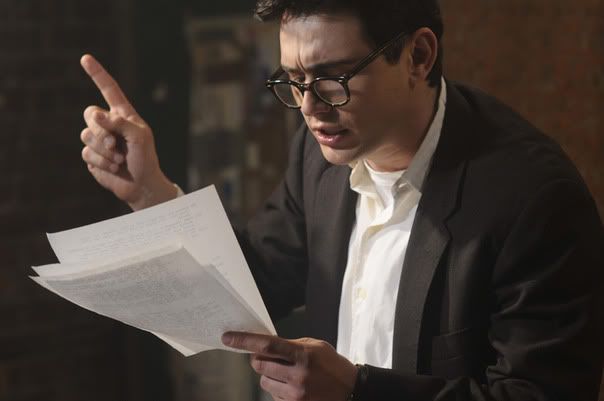HOME
This is the blog of Ian Rosales Casocot. Filipino writer. Sometime academic. Former backpacker. Twink bait. Hamster lover.
Interested in What I Create?
Bibliography

The Great Little Hunter
Pinspired Philippines, 2022

The Boy The Girl
The Rat The Rabbit
and the Last Magic Days
Chapbook, 2018

Republic of Carnage:
Three Horror Stories
For the Way We Live Now
Chapbook, 2018

Bamboo Girls:
Stories and Poems
From a Forgotten Life
Ateneo de Naga University Press, 2018

Don't Tell Anyone:
Literary Smut
With Shakira Andrea Sison
Pride Press / Anvil Publishing, 2017

Cupful of Anger,
Bottle Full of Smoke:
The Stories of
Jose V. Montebon Jr.
Silliman Writers Series, 2017

First Sight of Snow
and Other Stories
Encounters Chapbook Series
Et Al Books, 2014

Celebration: An Anthology to Commemorate the 50th Anniversary of the Silliman University National Writers Workshop
Sands and Coral, 2011-2013
Silliman University, 2013

Handulantaw: Celebrating 50 Years of Culture and the Arts in Silliman
Tao Foundation and Silliman University Cultural Affairs Committee, 2013

Inday Goes About Her Day
Locsin Books, 2012

Beautiful Accidents: Stories
University of the Philippines Press, 2011

Heartbreak & Magic: Stories of Fantasy and Horror
Anvil, 2011

Old Movies and Other Stories
National Commission for Culture
and the Arts, 2006

FutureShock Prose: An Anthology of Young Writers and New Literatures
Sands and Coral, 2003
Nominated for Best Anthology
2004 National Book Awards
Follow the Spy
Recent Crumbs
Blogs I Read
© 2002-2021
IAN ROSALES CASOCOT
Saturday, November 06, 2010
 2:28 PM |
How to Read a Poem Through Film
2:28 PM |
How to Read a Poem Through Film

I strangely find it difficult to articulate what I feel after seeing Jeffrey Friedman and Rob Epstein’s
Howl [2010] tonight. I came out of the Bijou knowing perfectly well what I felt about it: that I loved it. But why exactly? For most movies, it’s easy to give a reason for one’s liking or disliking its story, its themes, or its craftsmanship, opinions that ultimately boil down to the film’s handling of its formalistic elements. But the film is not like any other movie. It is not a typical narrative film told in a straight, conventional manner. In fact has the feel of a documentary. (Then again, the directors are primarily documentary filmmakers; both are responsible for what I consider to be the best chronicle about gayness in the history of film,
The Celluloud Closet.) Its structure is interesting bricolage. And its subject matter is quite unusual for a feature film. Perhaps it tickled my literary or intellectual fancy — this is a film that will be devoured by any creative writing and literary criticism major. I know that sounds snobbish, but in an age of filmmaking that is inundated by
Transformers movies and their ilk,
Howl becomes a breath of fresh air. Of course, there is a reason why the film takes its title from the pathbreaking poem by Allen Ginsberg, the beat writer who has become a generational icon and who is brilliantly portrayed in this film by James Franco. The reason is because it is a film of and about the poem, perhaps the first feature film that actually tries to do a cinematic treatment of a poem. (Is there any other poem that has gotten this cinematic treatment?) One may easily be led to believe though, from what we hear about the film in the grapevine, that this is a biopic. It is not. We do get generous snippets episodes (as well as psychoanalysis) of Ginsberg’s life, but these episodes are in the service of telling the story of the poem “Howl”. It is a film about its creation and about the furor of the obscenity case that was leveled against its publication by City Lights in San Francisco. It is also a film about its utterance — in a sense, a reading of the poem set to a visual rendition. And according to Stanley Fish, this is also the first film to do a thorough depiction of the act of literary criticism. I love the film. It is unusual, especially in terms of structure. There are four acts here that weave together in a kind of documentary finish: Ginsberg being interviewed about the poem, Ginsberg’s first reading of the poem at Six Gallery in San Francisco in 1955, the 1957 obscenity trial against its publisher Lawrence Ferlinghetti, and the entire poem read and set in animation. Each thread comment and enlighten each other, and so in a sense Fish is right:
the film becomes an act of close-reading, the first of its kind I see rendered in cinema. This will not be everybody’s cup of tea —but for those who are receptive for films that talk about literature, its creative process, its interpretative strategies, and its eventual reach for relevance or impact to society in general, this is the film to devour and watch, again and again and again.
Labels: film, poetry, queer, writers
[1] This is Where You Bite the Sandwich
GO TO OLDER POSTS
GO TO NEWER POSTS

















 2:28 PM |
How to Read a Poem Through Film
2:28 PM |
How to Read a Poem Through Film
